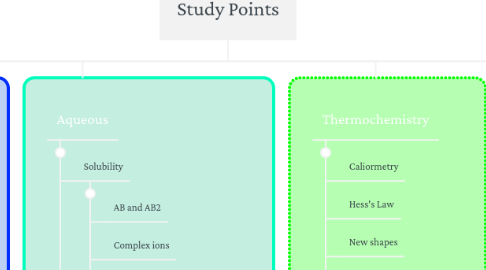
1. Thermochemistry
1.1. Caliormetry
1.2. Hess's Law
1.3. New shapes
1.4. Polarity
1.5. Bonding Types
1.5.1. Hydrogen bonding
1.5.2. PDDI
1.5.3. TDDI
1.6. Entropy
1.7. Enthalpy
2. Aqueous
2.1. Solubility
2.1.1. AB and AB2
2.1.2. Complex ions
2.1.3. Ks
2.1.4. Precipitates
2.1.5. Q
2.2. Species in solution
2.3. Acids + Bases
2.3.1. Weak acids bases
2.3.1.1. which arrow to use
2.3.2. Strong
2.3.3. Calculating pH
2.4. Buffers
2.4.1. Calculate pH of buffers using Ka
2.4.2. Buffering range
2.4.3. Indicators and turning point
2.4.4. pH curves
2.4.5. Titrations and titration curves
3. Waves
3.1. Types of waves
3.2. Reflection
3.3. Doppler effect
3.3.1. Doppler rearranging
3.3.2. Principles
3.3.3. Fixed observer
3.3.4. Doppler + Light
3.3.5. Doppler Graphs
3.3.6. Angles
3.4. Standing waves
3.4.1. Energy
3.4.2. Equations
3.4.3. String
3.4.4. Open pipe
3.4.5. Closed pipe
3.4.6. Beat frequency
3.4.7. Resonant frequencies
3.4.8. V=f Lambda effect on string
3.5. Interference
3.5.1. Double slit
3.5.2. Single
3.5.3. Multiple
3.5.4. Interference equation
3.5.4.1. To find # maxima
3.5.4.2. angle
3.5.4.3. explain white light / colours
3.5.5. Distribution of energy
3.5.6. Path difference
3.5.7. White vs Monochromatic
4. Mechanics
4.1. Laws
4.2. Vectors
4.3. COM
4.4. Centripetal force
4.5. Elastic or inelastic collistion
4.6. Vertical circular motion
4.7. Rotating motion
4.8. Rotational inertia
4.9. SHM
4.9.1. Sine / cosine
4.9.2. Speed
4.9.3. Acceleration
4.9.4. Conditions
4.9.5. Spring vs Pendulum
4.10. Reference circles
4.11. Translation and rotation characters need explain
4.12. Torque
4.13. Momentum
5. Human evolution
5.1. Endocranial features
5.2. Skeletal changes
5.3. Species
5.4. Food and Fire
5.5. Cultural evolution
5.6. Tools
5.7. Trends
5.7.1. Positive Cycle
5.7.2. Environmental Changes
5.7.3. what features enabled them to do
5.8. Dispersion
5.8.1. Out of Africa
5.8.2. Multiregional
5.8.3. Comparison
5.8.3.1. Main points and evidence
6. Plants and animal responses
6.1. Plants
6.1.1. Mechanisms of growth
6.1.2. Phytohormones
6.1.3. Tropisms + nastic responses
6.1.4. Photoperiodism
6.2. animals
6.2.1. Innate vs Learned
6.2.2. taxes + kineses
6.2.3. Navigation
6.2.3.1. Homing
6.2.3.2. Migration
6.2.3.3. benefits
6.2.4. Biological rhythms and clocks
6.2.5. Circadian rhythms
6.2.6. Actograms
6.2.6.1. Phase shift
6.2.6.2. Free running period
6.3. INTRAspecific relationships
6.3.1. Hierarchies and dominance
6.3.2. Home range + Territories
6.3.3. Mating systems
6.3.4. Parental systems
6.4. INTERspecific relationships
6.4.1. +-
6.4.2. Competition
6.4.3. Mimicry
6.4.4. Habitats
6.4.4.1. Gauses principle
6.4.4.2. stratification
6.4.4.3. zonation
6.4.4.4. ecological succession
7. Statistics
7.1. Variable types
7.2. Sampling
7.3. Confidence intervals
7.4. study types
7.5. Differences in proportions
7.6. Correlation and causation
8. Organics
8.1. Isonmers
8.1.1. Constitutional
8.1.2. Optical
8.2. Naming and drawing
8.3. Hydrocarbons
8.4. Hydrolysis
8.5. Equipment uses
8.6. Alcohols
8.7. Aldehydes
8.8. Ketones
8.9. Amines
8.10. Carboxylic acids
8.11. Flow chart questions
8.12. Reagents
8.12.1. Substitution
8.12.2. Oxidation
8.12.3. Elimination
8.12.4. Alcohol reagents
8.12.5. Aldehyde and Ketone reactions
